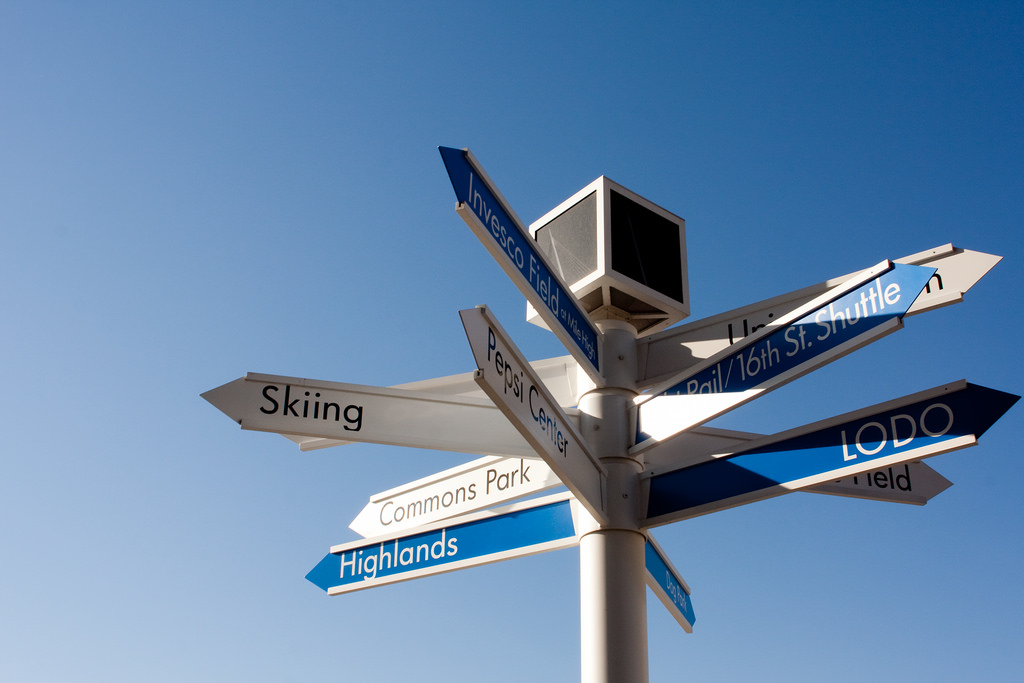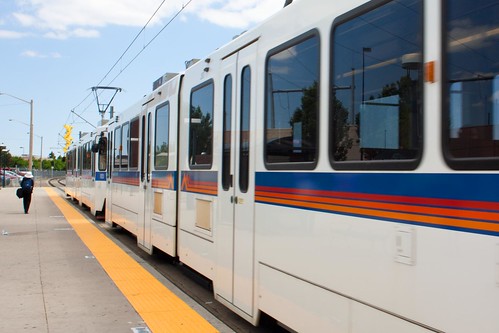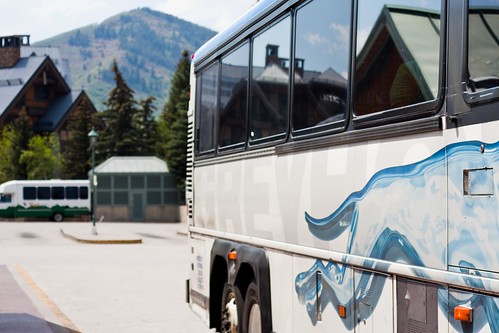(This is Part 1 of my Denver! Who knew? series. Check out the rest here.)
After the high that was the San Diego transit system, it only makes sense that we’d have a crash. Now, Denver public transit isn’t really that bad; it just seems they’ve put all their money on the excellent streetcars and 16th street shuttle, letting the workhorses of any transit system — the buses — suffer. But, then you have the super cheap, magical Greyhound-to-Vail connection, which maybe makes up for the other buses.
Let’s discuss.
1. The 16th Street Shuttle — “FREE MallRide”
You will likely ride the FREE MallRide shuttles at least 3 times a day if you are staying in downtown Denver. As the name implies, it’s free and it runs along 16th Street and only 16th Street, north to south, then south to north. Repeat.
Sixteenth Street is a pedestrian mall that cuts through the center of downtown Denver, and only these buses are allowed to traverse it’s brick streets. Since 16th Street cuts straight through downtown, you’ll likely use the shuttle to get within a few blocks of any spot or restaurant you want to go to.
On the southern end, 16th Street is chock full of all your mall stores: Barnes and Noble, The Sunglass Hut, Jamba Juice, etc. As you move northward, the shops turn into massive (mostly chain) restaurants and bars with patios: Rockbottom Brewery, Paradise Cafe, Tilted Kilt, Cheesecake Factory, etc.
Things get much much more local and chic once you near Market Street: you’ve entered the LoDo. There are still restaurants on 16th street, but you should venture off and explore Wazee Street and Larimer Street (this is the part of Denver that honest-to-God reminded me of lower Manhattan. That comparison doesn’t come lightly.)
The shuttle is free and comes about every minute or so. I’m not exaggerating, if you miss one shuttle, you’ll likely see the next shuttle just a block away. It runs from 5:00am (5:3o on Saturdays, 6:00 on Sundays) to 1:06am. Expect it to be chock full of people no matter what time you get on. It is very popular.
2. Streetcar Lines
Denver has five streetcar lines that cycle through downtown Denver and take you to the southwest regions of the city. Catch outgoing streetcars along Stout Street and Union Station.
Each line consistently comes about every 10 to 15 minutes during the day, which is pretty excellent service (ahem, Muni), and they run until 2am. The streetcars themselves were super clean and looked brand new.
Denver RTD uses a zone fare system, but most close-in stops are in Zone 1 and cost $2.25. You have to buy a ticket at a kiosk before boarding the train, but we found the kiosks pretty easy to use if a little slow to print.
The catch is the limited service area (see map). You won’t use the streetcars to get around downtown. Once out of downtown, the five streetcars separate into only two routes. If that’s where you’re headed, terrific. If not, you have to get on a bus.
3. Denver RTD Buses
Buses are a problem in Denver. I’m not sure if I was just spoiled coming off of San Diego, but I found using the buses here frustrating.
A bus ride costs $2.25. You have to have correct change when you board the bus. Here’s a map of Denver’s bus routes. Yes, the map is hard to read.
On most routes (re: any route I ever wanted to take), buses only come every half hour (see Bus Schedules). For some reason, RTD hasn’t estimated arrival times at each bus stop. At all. Instead, bus schedules list the arrival time for your stop with a helpful little asterisk. If you read the footnote, you’ll see that the time listed is actually the time that the bus left some other intersection, miles away.
Hey, RTD: not helpful.
This has a chain result of bad repercussions. My Google Map App, which I had used to such great success in San Diego, was useless in Denver. Google assumed that the bus’s “arrival” time was the time listed on the schedule. Google didn’t catch that asterisk.
So, the arrival times were always 20 to 25 minutes off, depending on how far away the bus depot is. (This is me arriving fresh eyed, 5 minutes before the scheduled arrival of the Route 20. This is me ten minutes later, staring at a team of tree trimmers as they climb a Black Walnut tree with machetes strapped to their thighs. Twenty minutes later, watching these tree acrobats work wonders, I’m pondering whether little boys and girls know that this is a viable career option, climbing trees for a living. Twenty five minutes later, my bus arrives and I’ve forgotten all about where I wanted to go and why.)
RTD’s online route planner is equally unhelpful because it just uses the Google Maps API — it gives you the same exact results as Google, and is wrong in the same exact way.
I now think the best way to use Denver buses is to ignore the schedule and wing it. Worst case, it’s a half hour wait. It’ll save you the frustration of trying to figure out what time a bus is ever going to come, only to realize you are totally wrong.
In the meantime, maybe we can convince RTD to hire a team of interns this summer to figure out bus arrival times at each of their stops.
4. Denver Bikeshare, or Denver B-cycle
As I mentioned in my intro, Denver’s Bikeshare program, Denver B-cycle, is over 2 years old now, and it’s quite a success. In DC, the bikeshare stations were all so gleaming with red, shiny bikes all in perfect rows. Until you realize that all those bikes sitting there meant that no one was using them. In Denver, the stations were rarely a quarter full.
The way to use B-cycle is to think of each of the bike stations as bus stops — you pick up a bike at one station and drop it off at another station that’s close to your final destination (here is a map of all 52 B-cycle stations). You don’t use the bicycle all day and lock it up at random poles. B-cycle does not provide helmets; you have to bring your own. (Fine, you don’t have to, and it seemed like a lot of people in Denver were not wearing bike helmets. But, we’re talking about our brains here, people. Brains.)
To use B-cycle, you can sign up online or go to one of the station kiosks. You pay as follows:
0-30 min Free
30-60 min $1
Additional 30 min $4
24-hr pass $8
7-day pass $20
30-day pass $30
Annual Pass $100
If you just want to test it out or go on a riverfront joy-ride (remember: 850 MILES of paved bike paths), I highly recommend it. The riverfront parks here are wonderful. If you want to use it to get around the city, I recommend that you’re already used to cycling on city streets. Denver didn’t seem to have many on-street bike lanes, like in San Francisco. This was confusing until I realized it was because their bicyclists are fit enough to travel as fast as cars. It was electrifying. And terrifying.
5. Greyhound
If you find yourself in Denver, for a conference or work trip, it might be totally worth your while to head out to Vail for the weekend. See how easy that sounds? “And then I decided, hey, why not spend the weekend in Vail.” Colorado, it just keeps on giving.
Dave and I spent days searching for an affordable way to get to Vail, about 2 hours west of Denver. There’s a shuttle that leaves from the Denver International Airport, which is mad expensive and inconvenient since the airport is a half hour EAST of Denver.
And then the light shone down from the heavens and we remembered that our nation is FULL of clunky old buses happy to take you down interstates and drop you off in random small towns, for the price of a pack of gum.
Yep, Greyhound. All you need to do is walk to the downtown Greyhound Station, board the bus, and then step off at the Vail Transportation Center, a staircase away from the heart of Vail’s Normandy village and cobblestone streets.
(If you haven’t been to Vail, one of the weirdest things about it is that all that pristine Alpine skiing is roughly 10 ft away from a major interstate highway. This makes it easy to get to using Greyhound. If you want to go to Aspen or Telluride, the Greyhound trick won’t work.)
One-way tickets are $32 online or $35.50 at the station. Buses leave twice-a-day at around noon and 7pm. If you want to splurge, you can pay an additional $5 and get VIP service: you get to board first and don’t have to wait in the long Greyhound Station line. It’s worth it.
I’m not gonna lie: even a Greyhound Station in lovely Denver is still a Greyhound Station. Red tiled floors and cement walls. Lots of folks that may just be hanging out there for the day. But, they have a charging station with chairs. And, the snack bar is small but has a surprisingly good selection of food (turkey sandwiches, fresh looking salads, a variety of cereals, milk) and traveling goodies (fleece blankets, pillows, duffle bags.)
Happy Traveling!











